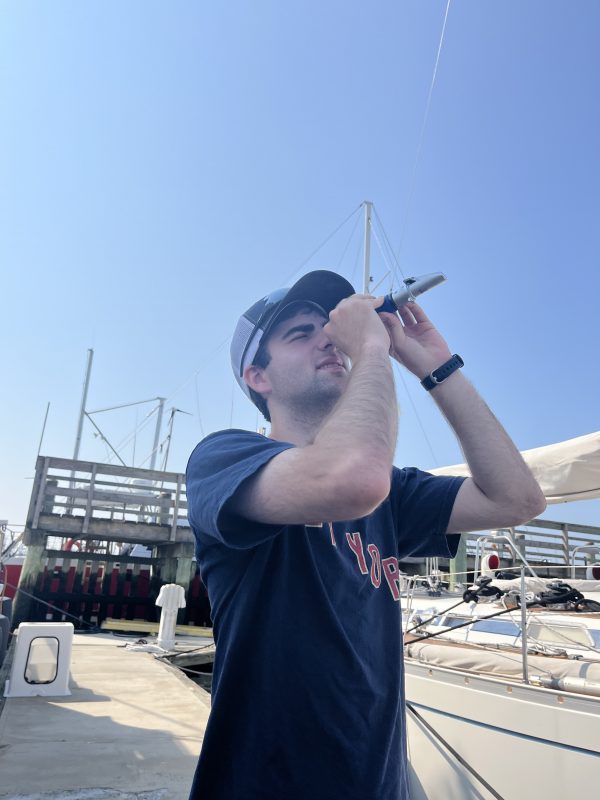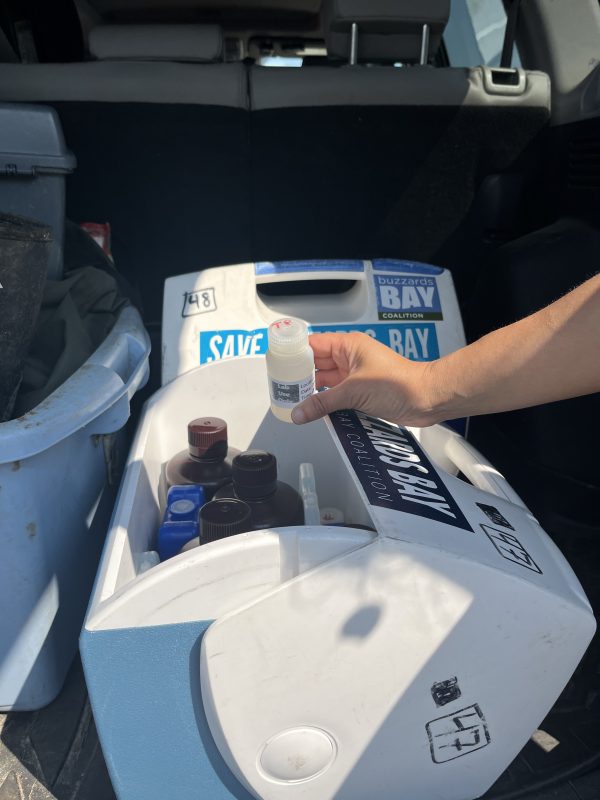Summer of Science: Water Testing in Full Swing
Sara Quintal is a restoration ecologist for the Coalition. But on special days in the summer she is part of a huge, all-out effort by staff and volunteers called Nutrient Day. It’s a race to collect the samples from the scores of sites around the Bay during the last three hours of an outgoing tide.

Caleb Friedman uses a refractometer to measure salinity levels at Pope’s Island Marina.
With her summer intern Caleb Friedman early on this brilliant Monday morning, she travels along the path of the Acushnet River into the Harbor from the New Bedford Reservoir to the Moby Dick Marina. Their collection of water samples at their six designated sites is but a portion of this comprehensive effort that takes place across the entire watershed on July 7, July 21, August 5, and August 19. Welcome to the 34th season of Nutrient Days.
Here at Pope’s Island Marina, the duo records temperature, salinity, and observed water clarity—data that water quality monitors regularly collect weekly at their sites throughout the summer—before filling an opaque brown plastic bottle with water from their current site. All samples must be taken during the three-hour window, so the two have little time to linger and enjoy the picturesque views.
They label their brown bottle with site ID, date, time, and whether it was taken at the surface or the bottom. It immediately goes into a cooler so the microscopic marine life will not alter the nutrients before the sample is filtered. After Quintal and Friedman collect their samples, they head the Coalition’s Marion facility. There, all the volunteers drop off their measurement equipment and brown bottle samples, before making their way by car to their ultimate destination in Woods Hole: the Woodwell Climate Research Center’s lab.
This specialty lab has the capabilities to measure all sorts of things. For the scientists among you, that means dissolved forms of nitrogen, phosphorus, and organic carbon; particulate forms of carbon and nitrogen; and phytoplankton pigments (phaeophytin and chlorophyll). They will also test for total phosphorus in samples from freshwater rivers/streams that flow to Buzzards Bay.

A cooler for the staff and volunteers’ samples.
Quintal and Friedman take all their samples from land, as does Director of Monitoring Programs Tony Williams, who has a half dozen sites himself in the east portion of the Watershed. There are also a number of long-term volunteers who offer their services with their boats to collect samples within the Bay.
Ultimately, nutrient levels will be analyzed and results will be used to understand how the area’s waterways are affected by wastewater pollution, primarily from septic systems, and other causes of nutrient runoff that impact water quality.
As you read this, another multi-day marathon of vegetation and fauna collection is underway in salt marsh runnel sites, during the lowest tidal amplitude within the first two weeks of August. Bay Science staff collect half of their total vegetation and fauna data at three designated runnel sites during this time. Stay tuned for more on this!
Thank you, local legislators!
Many thanks to our Buzzards Bay Watershed legislators for coming through for annual funding support for water quality monitoring. This group includes Senators Rodrigues, Montigny, Cyr, Fernandes, and Dooner, as well as Representatives Markey, Badger, Cabral, Gaskey, Moakley, Ouellette, Sylvia, Vieira, and Xiarhos.